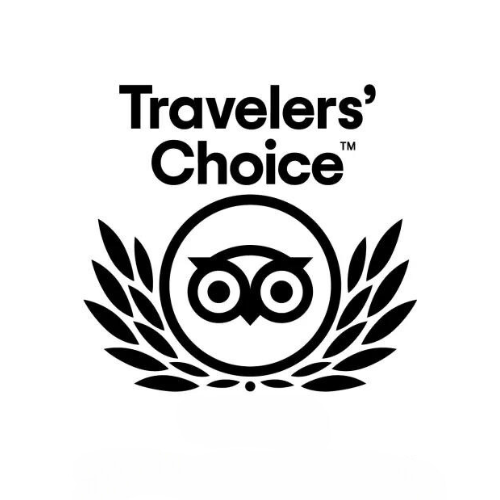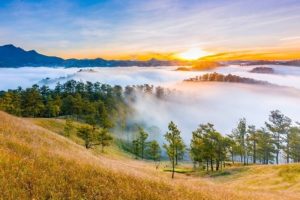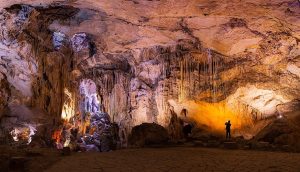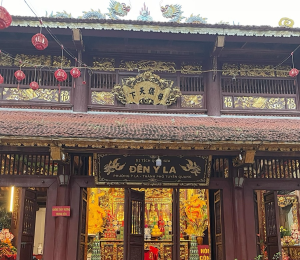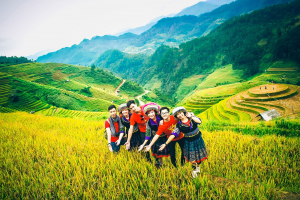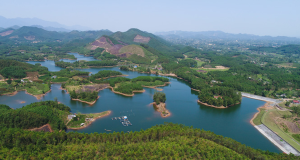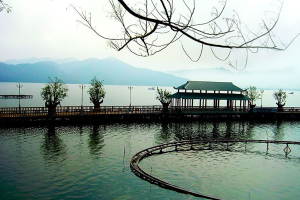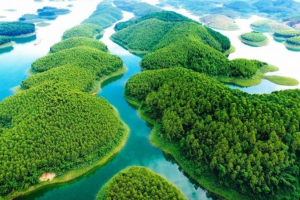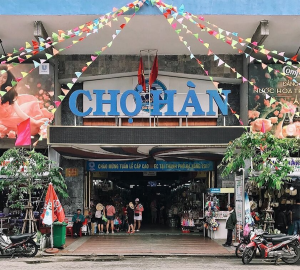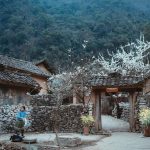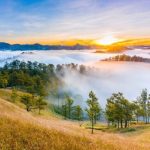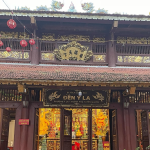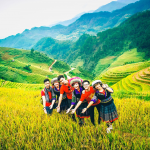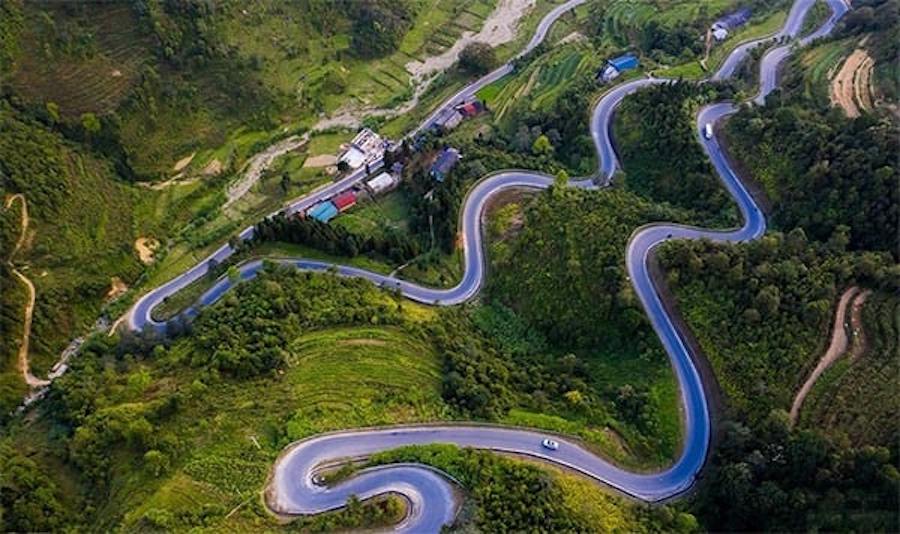
Those who adore the Northwest region and are passionate about conquering undoubtedly all wish to come to Yen Bai once. A lot of people desire to cross the Khau Pha pass to see the beautiful mountains and trees. They blend in with the lyrical beauty of the villages and the cultural colors of the highlands.
What is Khau Pha Pass?

Khau Pha Pass Vietnam is one of the “four great mountain passes” in the Northwest highlands, along with Pha Din Pass, O Quy Ho Pass, and Ma Pi Leng Pass. Khau Pha Pass is in Yen Bai province and is around 30 kilometers long and 1,200 meters high. This is the pass that separates the Van Chan and Mu Cang Chai districts. The Khau Pha Pass is well-known for its treacherous hairpin turns and steep rocks that make it difficult to drive. This mountain peak is called “Horn of Heaven” in the ethnic tongue. It looks like a mountain horn sticking up into the sky, and the top of the pass is always covered in fog.
The most remarkable part about ascending Khau Pha Pass is seeing the beautiful natural surroundings up close. Visitors can look at the mountain ranges that look like curved horns coming up through the white skies. The winding pass roads that connect the ancient woodlands with the terraced farms of the H’Mong and Thai people.
The weather is chilly all year round because this place is so high above sea level. There are four seasons in a day in Khau Pha: Spring, Summer, Autumn, and Winter. The best time to see the stunning scenery in Khau Pha Pass Vietnam is in September and October, when the rice is ripe. During the season, visitors to Khau Pha will observe the transformation of the terraced fields as they change color from green rice to golden ripe rice.
Crossing Khau Pha Pass, surrounded by floating clouds and mountains, while taking in the stunning scenery of the wide sky and beautiful mountains, offers an amazing experience for those who love adventure and appreciate the breathtaking beauty of the Northwest region.
Best time to visit Khau Pha Pass

The best times to go across Khau Pha Pass are during the rice harvest season (September to October) or the flood season (May to June), when the scenery is at its best. Also, you shouldn’t travel during the rainy season (July to August) because the pass can be slick and dangerous.
- Ripe rice season (September – October):
The best time to see the beautiful golden terraced fields that sweep over the hillsides is during the ripe rice season, which runs from September to October. The stunning picture of the golden color of mature rice at Khau Pha Pass Vietnam captivates the viewer.
- Water pouring season (May – June):
Water pouring season (May to June): When the first rains of the season fall, water runs into the terraced fields, making white waterfalls that add to the beautiful and stunning panorama.
- Avoid the rainy season (July – August):
The wet season in the northern mountains lasts a long time and makes it hard to travel. At Khau Pha Pass, both people and cars are at risk due to slick conditions and the possibility of landslides.
Read more: Nguom Ngao Cave: A rare natural masterpiece in Cao Bang
What to expect at Khau Pha Pass
The views of the high mountains of Yen Bai from the Khau Pha Pass are without a doubt the best thing about the trek for everyone.
Admire the brilliant scenery of mountains and forests, nature

If you can get to the foot of Khau Pha Pass Vietnam, you can gaze up and see the top of the pass, which looks like a curving horn that goes straight up into the sky. The pass’s view is made even more beautiful and hard to describe by the clouds and mist that linger all year. At the top of the pass, mist and clouds linger year-round, enhancing the beauty of the view beyond words.
When you reach the top of the pass, you’ll be able to see very well after driving on roads with big hills and many hairpin turns. From here, you can readily see the terraced fields below, which look like delicate peach silk hanging over the hill. During the ripe rice season, you’ll be able to see the beautiful sight of ripe rice and valleys covered in green hills. All of these together paint a picture of a lively northwest Vietnam.
Conquering the most dangerous mountain pass in the Northwest
Khau Pha is one of the “Four Great Passes” of the Northwest highlands, together with its “neighbors” O Quy Ho, Pha Din, and the beautiful Ma Pi Leng. Even though it’s just 30 kilometers long, you’ll need to go extremely carefully the whole way to keep yourself and others safe and to properly enjoy the beautiful and untamed nature of this location.
When you finally get past all the problems, you’ll see that all your hard work and bravery were worth it. You might not realize how hard you’ve worked until you reach the top of Khau Pha Pass and look out over the wild yet beautiful mountains, rivers, clouds, and sky.
Skydiving near Khau Pha Pass

Khau Pha Pass Vietnam has also begun offering skydiving from high above the pass, which is an intriguing activity. If you have heart problems or any other serious health issues, it is advisable not to participate in this activity at all.
Explore to Mu Cang Chai

You may get to Mu Cang Chai after crossing the beautiful Khau Pha Pass. There are still beautiful terraced fields along the slopes, the most famous of which are the La Pan Tan terraces. You can enjoy the image that shows the beauty of work and the hidden link between people and nature, as well as the land and sky. You can also experience the basic life of the highland inhabitants. All of them vow to provide you memories that will last a lifetime on the way to Yen Bai.
Enjoy the rich flavors of Western cuisine

After a long and tiring journey to conquer Đèo Khau Phạ, you can recharge your batteries with some delicious Northern Vietnamese food. Some of the delicious foods you shouldn’t miss when you come here are grilled wild boar, apple pie, five-color sticky rice with peanut butter, salted crab, salmon, and more.
Learn about the culture of ethnic groups at Lim Mong Village

The people of Lim Mong village are mainly Mong people who have lived together for a long time. Their lives are closely linked to terraced fields, slash-and-burn farming, animal husbandry and weaving. Traditional houses are wooden houses or stilt houses, roofed with po mu or old corrugated iron, simple but warm.
Here, visitors can join the locals in farming, picking Shan Tuyet tea, or learning to embroider, weave brocade and experience cooking with local families with traditional dishes such as thang co, men men, and five-color sticky rice. In addition, visitors can also experience folk arts such as the Mong flute, singing duets, singing responses…
Discover the cuisine in Tu Le valley
Tu Le valley

The highland sticky rice variety, which is long-grained, clear white, aromatic, and sticky when cooked, is what Tu Le is most known for. Tu Le sticky rice is grown on high mountain land, where the climate is pure and the water comes from a chilly stream. Its texture gives it a taste that can’t be found anyplace else.
Tu Le sticky rice is used to make highly rich special dishes:
- The sticky rice in Tu Le is soft and smells delicious. People commonly eat it with sesame salt, grilled pork, or cham cheo.
- Tu Le green rice is prepared by hand from young sticky rice. It has a sweet, sticky, and fragrant taste.
- Banh chung and banh giay produced with Tu Le sticky rice have a strong flavor. They are not dry or mushy like conventional sticky rice.
Scenic routes and stops along Khau Pha Pass

Khau Pha Pass takes travelers from the foot of the Van Chan district to the Mu Cang Chai district. The 30-kilometer route, filled with numerous twists, requires the driver to maintain a high level of focus.
There are several possible problems on Khau Pha Pass Vietnam because of its abrupt, narrow turns. Every turn is exciting, especially for people who love to go backpacking. But you must obey traffic laws to be safe and make the road safer.
Khau Pha pass is not just a difficult road; it also draws tourists because of its beautiful natural scenery. Visitors may see the overlapping mountain ranges and lush terraced fields from above, which make a lovely natural image.
Highlight stops along Khau Pha Pass:
- Lim Mong Village: This village is at the bottom of the pass and is a wonderful place to learn about Thai culture. Visitors can learn about the culture and way of life and try local foods.
- Mu Cang Chai: The Khau Pha Pass Vietnam leads to this mountainous area. The terraced fields are breathtaking, especially during the rice harvest season from September to October. Visitors to Mong villages can observe the local inhabitants’ way of life and sample distinctive foods such as five-color sticky rice, Tu Le green rice, grilled hill chicken, and more.
- La Pan Tan: La Pan Tan Commune is another place you should definitely go. People say that the terraced fields here are one of the most attractive spots in Mu Cang Chai.
- Che Cu Nha and Nam Co: These two communes are also on the pass and feature magnificent terraced farms. They aren’t as well-known as La Pan Tan, but they are still worth a visit.
- Khau Pha Pass: The top of the pass is a wonderful site to overlook the full Mu Cang Chai valley and the beautiful mountains that surround it.
Local culture and community around Khau Pha Pass
The Khau Pha Pass area in Vietnam is known for its beautiful terraced rice fields and the lively culture of the ethnic minority groups that live there. The Hmong, Thai, and Dao people, among others, live in these settlements. They provide the area its own traditions, festivals, and a strong connection to the soil, especially during the harvest season.
Here’s a closer look at the culture and community:
Cultural Importance and Ethnic Diversity
There are several different ethnic groups living in the Khau Pha Pass area, and each one has its own languages, cultural practices, and traditions. According to the Saigon Times, the pass is more than simply a physical landmark for these people. It has spiritual meaning and is a place to find peace, pray for good weather and crops, and connect with nature. The harvest season (as Lily’s Travel said above) is a very lively time, with events honoring the area’s rich cultural history and the beauty of the terraced landscapes.
Farming and Terraced Rice Fields
The most important thing about the area is the complicated network of terraced rice paddies that flow down the mountainsides. The terraced fields show how smart and skilled the people in the area are at farming. During the harvest season, the countryside turns into a sea of gold, showing off the beauty of the rice terraces and the hard work that went into them.
Food and drinks that are unique to the area
The area has certain unusual foods, like “Tú Lệ” green rice flakes, which are formed from young rice grains and have a nice smell. Salt-roasted stream crabs, fresh salmon from surrounding rivers, and “Tao meo” (Docynia indica), a sweet and crunchy fruit, are among other local foods.
Tourism and Community Involvement
More and more people are coming to the Khau Pha Pass area to see the sights and learn about the local culture. There are homestays and guesthouses in adjacent towns like Tu Le and Mu Cang Chai where you may stay and learn about the culture while helping the local community.
Problems and Preservation
The area has problems with sustainable tourism growth and keeping its distinctive cultural heritage alive. Promoting responsible tourism can assist make sure that the local people benefit from the area’s growing popularity while yet keeping their traditions alive.
Tips for visiting Khau Pha Pass

When you visit Khau Pha Pass Vietnam, the famous road in the Northwest region known for its stunning scenery and difficult challenges, here are some helpful hints:
1. Choose the best time
Lily’s Travel wrote an article about the best times to go to Khau Pha. Pick the best time to visit Khau Pha, but also the best time for your trip to Vietnam so you can see other locations in Yen Bai.
2. Get your car and driving skills ready
The Khau Pha Pass is around 30 kilometers long and features many tight twists, high passes, and steep slopes.
If you’re going by motorcycle, get one with a manual transmission, a robust engine, and excellent brakes. Because there aren’t many gas stations along the route, you should fuel up at Tu Le or Mu Cang Chai.
If you drive your car, you should give priority to cars with high chassis. Be careful since the road is quite small and there are many places where there are no barriers.
Drivers should know how to drive on mountain passes. Don’t drive at night or when there is a lot of fog.
3. Don’t miss the wonderful places to check in on the pass
Paragliding spot: From the top of the pass, look down at Tu Le valley, which is one of the most beautiful places to fly in Vietnam. You can join the “Flying over the Golden Season” festival when the rice is ready to be harvested.
Khau Pha Heaven Gate is the highest point of the pass. From there, you can see all the terraced fields and clouds that encircle the mountains.
La Pan Tan Raspberry Hill is near the end of the pass. You can pull over to snap pictures of the famous round terraced fields that are so lovely.
4. Bring plenty of your own things
- Bring a scarf and jacket because the temperature on the pass can drop significantly, especially in the early morning and late afternoon.
- Sunglasses and sunscreen: These things will protect your skin and eyes when you go a long way.
- Drinks and snacks: The road is empty, and there aren’t many stores.
- Bring a camera and a fully charged phone to capture unique and beautiful moments.
5. Get involved in the daily life of the area
- You can explore Lim Mong village, Lim Thai village, and Tu Le, which are all lovely communities located at the foot of the pass.
- Enjoy Tu Le’s specialties include sticky rice, grilled stream fish, smoked buffalo meat, and maize wine infused with yeast leaves
- Stay overnight at a guesthouse in Tu Le or Mu Cang Chai if you have the time to really get a feel for the highlands.
Khau Pha Pass is only 30 kilometers long, but its sharp turns are enough to scare many people. So, do you like to climb this beautiful pass and see the Yen Bai highlands from above? Please get in touch with Lily’s Travel right away if you need help with the route and how to get to Khau Pha Pass Vietnam. We always provide tours that are perfect for a lot of foreign guests.
Read more: Tram Tau Hot Spring: A perfect paradise for relax

